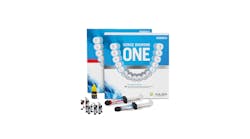Composite resins by their chemistry are somewhat chameleon-like in their ability to blend to surrounding tooth structure. Venus One takes this concept to the next level by blending, or as they call it, “color adapting,” quite well, regardless of the shade of the tooth being restored.
Venus One does this by absorbing the light waves reflected by the remaining tooth structure that surrounds the prepared site. This highly radiopaque material comes in two consistencies: Venus Diamond One is firmer, more packable, and adapts well to cavity walls. Venus Pearl One is creamier, and both are seemingly less sticky than competitor products. I do like the creamier Venus Pearl One as a restorative for the anterior dentition, especially in a class III. I like Venus Diamond One in the posterior because of its higher fill and firmer consistency. Both Diamond and Pearl offer low shrinkage stress and high flexural strength that makes for a strong restoration. This is due to proprietary TCD-urethane chemistry that not only provides excellent physical properties but makes the material BPS- and BisGMA-free. Both Venus One products are available in either syringe or unit-dose format, and each has a nice starter kit that includes Kulzer’s terrific iBond Universal bonding agent. Venus de Milo may not have had arms, but this material has “legs”!
Howard Glazer, DDS, FAGD, is a columnist for Dental Economics. He is a key opinion leader in dental products and maintains a general practice in Fort Lee, New Jersey. Dr. Glazer is a fellow and past president of the Academy of General Dentistry (AGD). He lectures frequently on the subjects of dental materials, cosmetic dentistry, forensic dentistry, and patient management.







